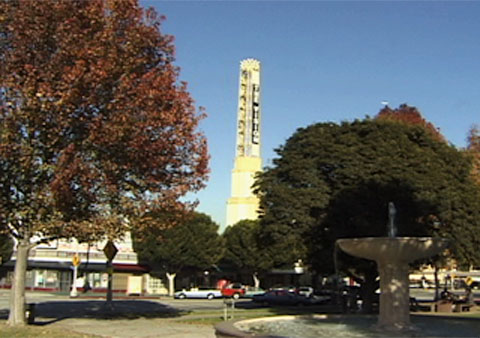
The History

Leimert Park is a one and a half square mile planned community in the Crenshaw district, designed by Olmsted and Olmsted, a firm headed by sons of Fredrick Olmsted, the architect and master planner of New York City’s Central Park. It was created by Walter H. Leimert in 1927 as one of L.A.’s first planned communities. It was restricted to white residents until 1948, when Los Angeles’ restrictive covenants were struck down by the Supreme Court. Restrictive covenants, clauses written into property deeds that restricted where people could live, were initially created to keep the Asians, Mexican and Jews from moving into white neighborhoods. But as the black population in Los Angeles grew, the covenants were used to restrict their migration into white neighborhoods as well.
Although blacks had lived in Los Angeles since before the turn of the century, the real black migration began in the 20’s, 30’s and 40’s. Newspapers and Pullman porters who moved back and forth across the United States spread the news that Los Angeles was a place where African Americans could buy homes and get decent paying jobs. In the 20’s and 30’s and 40’s however, blacks were forced to live in an overpopulated area along Central Avenue. 91-year-old Leimert Park resident, Verna Deckerd Williams, came to Los Angeles from Texas in 1924. White men had burned down her father’s auto shop in one town and beaten him in another. Hearing that there was opportunity in Los Angeles, he moved his family out but was faced again with the same racial hatred. They moved into a house on 58th Street and the whites wanted them out. The white neighbors tried initially buying them out and then forcing them out:
“Fifty of them came to our house and stood on the lawn. Two of them came up to the door. The other forty-eight stood on the lawn with a sign, ‘KKK’s,’ and it took the local sheriffs two hours before they came. And by the time they got there, Papa was home and Papa was cleanin’ his Winchester. He had a Winchester from World War I. So he was cleaning it and getting ready for ‘em. If they were gonna come back, he was gonna start shootin ‘cause he said, ‘I’m not runnin’ anymore.’ He left Texas because of the problem and he said, ‘They’re not gonna run me out of my home.’
So he got a gang of people from 12th and Central. That’s where the colored business section was at that time. They volunteered to come out there and help us protect our home. And so every night they’d set up all night waitin’ for ‘em to come back. But they never came back, so finally after a month, Papa stopped havin’ the people there and we all settled down.”
Until 1948, blacks could not live west of Western Avenue. And while the covenants were enforceable by law, their effectiveness depended on the vigilance of the white neighborhood. Minorities went to great lengths, however to break the covenants. Sometimes, light skinned blacks would pose as the buyers, then would move their darker skinned neighbors or family into restricted areas. After the restrictive covenants were struck down, African Americans began to move west in greater numbers. First settling along Western Avenue in the 50’s and then further west to Crenshaw Boulevard.
Realtors took advantage of the situation, scaring the whites out of the Crenshaw area with a technique known as “block busting”… frightening the whites into selling their homes by suggesting that their children would be mixing with these “bad elements” … that it would “no longer be a safe community.” The Crenshaw Neighbors Association, formed in 1964 with whites, blacks and Asians in the area, worked to maintain an integrated community. However by 1960 many of the area’s whites had fled. The Crenshaw District, while still integrated, became the core of the black community.Leimert Park Village, the shopping district, is a cultural mecca with the character of Greenwich Village. Leimert Park itself is a triangular park at 43rd Place. The village is a one square block bordered by Crenshaw Boulevard, Leimert Boulevard, 43rd Street and 43rd Place. Leimert Village’s main street, however, is Degnan Boulevard. With its two story Mediterranean style buildings, it runs through the center of the block.
Over the years this area has become an oasis of African American art and music. It all began with the Brockman Gallery founded in 1967 at 4334 Degnan. Says Brockman co-founder Alonzo Davis, “After the Watts riot, there were a lot of artists doing works that were politically significant. They were making statements that were social. We filled a gap and a void there. We just opened a window that had never been available, especially on the West Coast.” The Brockman Gallery nurtured the early careers of respected artists like David Hammons and John Outterbridge, and the more established black artists also exhibited there – Elizabeth Catlett, Charles White, John Biggers, Noah Purifoy and Romare Bearden.
The Brockman Gallery no longer exists, but the cultural renaissance it fostered during the 70’s and early 80’s continues. The area today is struggling to maintain it’s identity as several of the long term tenants are being forced out by redevelopment and rapidly increasing rents. But the area still boasts galleries, coffeehouses, performance spaces, restaurants, and Afrocentric fashion and merchandise shops.
